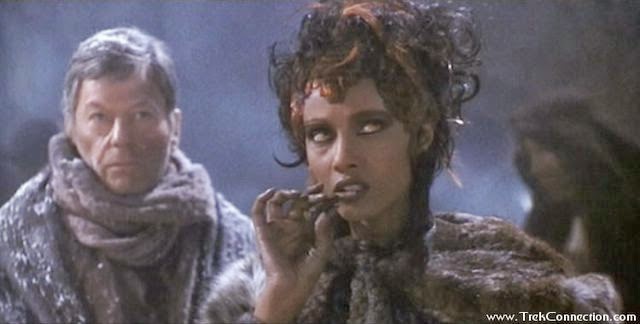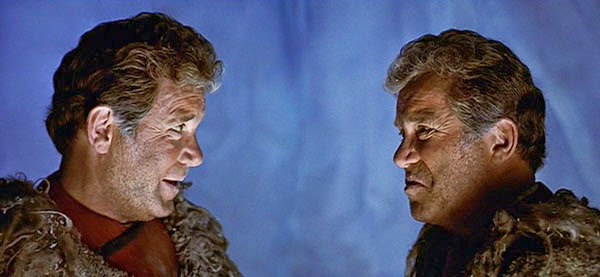
Midway through that end-of-the-Cold-War allegory Star Trek VI: The Undiscovered Country (1991), Captain Kirk and Dr. McCoy are sent to a Klingon gulag after being framed for the assassination of the Klingon High Chancellor. While Spock and the crew of the Enterprise are busy planning their jailbreak, solving the who-dunnit, and preventing full-on war, Kirk and McCoy are befriended by a fellow inmate named Martia, who informs them there is already a hit out on them. She offers them her experience and expertise to help all three of them escape. Martia later turns out to be an alien shape-shifter, one who can transform into whatever image she needs to survive, dependent on the situation.
This shape-shifting aspect of Martia becomes all the more problematic once one becomes aware that the actress playing her is Somali-American supermodel Iman (full name: Iman Mohamed Abdulmajid), a person who in real life was already quite skilled at shape-shifting to navigate the fraught racial dynamics of contemporary America.

As a fashion-conscious friend once explained to me in grad school, Iman is the daughter of a Somali diplomat who traveled the Middle-East; she was discovered at Nairobi University in Kenya by fashion photographer Peter Beard in the mid-1970s. At the time of her first visit to New York, she was fluent in 5 languages and was already highly educated and deeply cosmopolitan. However, when she arrived, she learned that Beard had marketed her as this “goat-herder’s daughter,” as some sort of illiterate, rustic rube, such that the Press was caught off guard when she responded to their questions in fluent English.
That moment appears to be pretty representative of her career entire: she was forced right from her modeling debut to conform, change, shape-shift to the expectations others had for her–and it hasn’t always a smooth ride. Though she achieved instant stardom, she was constantly “too ethnic” for some white audiences, while “not black enough” for some African-American ones. She was under constant pressure to appear both more and less “authentically African,” and was often taken to task for failing the impossible expectation to be both.
As if to underscore her constant navigation between multiple worlds, in 1992 she married British rocker David Bowie, who himself has a professional reputation for being a musical shape-shifter, constantly reinventing himself and trying on new identities every few years. What he chose to do, she had to do. Perhaps she clicked so well with her Ziggy Stardust-alien of a husband because she was of necessity an alien shape-shifter herself, long before she played one in Star Trek VI.
Indeed, at one point in the film, in order to escape her leg-brace in the mining level during Kirk and McCoy’s thrilling escape, Martia shape-shifts into a small blonde white-girl–which, given the way that whiteness continues to define American beauty standards (standards that Iman had to both conform to and transcend throughout her entire modeling career), is almost a meta-commentary on the American fashion industry itself.

When she, Kirk, and McCoy finally escape to the surface of the prison planet, she then transforms into this large, Yeti-like monster to withstand the extreme cold, then back to the sexy Martia we first met when they break for camp. McCoy asks if “there is any way of knowing if this is the real you?” which had to have been a question that Iman was both asked–and asked herself–way too often throughout her career. She responds by paraphrasing Polonius to Ophelia: “I thought I would assume a pleasing shape,” which is a strategy that, again, Iman doubtless had to often adopt just to survive the racial minefield that is the Western fashion industry.
But Kirk isn’t the only one for whom she’s assuming a pleasing form; as Kirk soon realizes, she merely staged their escape for the benefit of the Klingons in exchange for a “full pardon”, as part of a larger conspiracy to make it look like Kirk and McCoy were killed in flight from prison. She even parodies her “pleasing shapes,” wielding her shape-shifting as a weapon (as, again, Iman doubtless had to) as she transforms into Kirk, then attacks him.

But alas, her strategy of conformity fails, as the Klingon prison guards vaporize her anyways when they find all three of them, so as to ensure there are no witnesses to their conspiracy. Kirk and McCoy are of course beamed out by the Enterprise in the nick of time, and then warp off to prevent the assassination of the Federation president–but not without leaving the viewer with a sour taste in the mouth for the fate of Martia. She had, in effect, been placed in a no-win situation, as all the pressures to conform to “pleasing shapes” in a thousand contradictory ways still end in her being betrayed and disappeared.
Like Ophelia of yore, her attempts to please everyone please no one, ultimately causing her to disintegrate, tearing her apart, killing her quite literally. Iman, fortunately, has had a happier time of it in real life than Ophelia–though many women, particularly women of color, have been far less fortunate.
But then, we are all shape-shifters to some degree, aren’t we? The way we speak at, say, church, is different from how we behave at work, or at work, or with family, or with friends. In none of these things are we being “inauthentic” or what have you; nor is it to minimize or trivialize the pain who gave had to literally shape-shift just to survive. This is not an excuse to be dishonest to others and certainly not to further silence them, but on the contrary, it is only to cut each other and ourselves a little more slack. Even in the purported utopia of Trek or whatever Zion turns out to be, there remain many who need to shape-shift to survive. Do not denigrate them; join them. Embrace them. Become them. Odds are you’re one already without realizing it–similar to how we are all children of God without realizing it. To paraphrase King Benjamin, are we not all shape-shifters? Do we not all depend upon the same being, He who is in and of and through all things, yea verily, even the greatest shape-shifter of all?
Besides, eternity is too long, and the universe too infinite, to confine ourselves to only one identity. Hence, perhaps, why section 132 reads “This is eternal lives…” plural, many, every-churning, every-changing, infinite.
